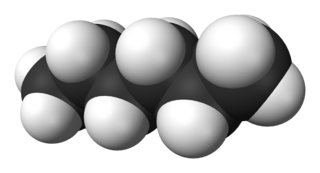
Hexane or n-hexane is an organic compound, a straight-chain alkane with six carbon atoms and has the molecular formula C6H14.

Jamaica ginger extract, known in the United States by the slang name Jake, was a late 19th-century patent medicine that provided a convenient way to obtain alcohol during the era of Prohibition, since it contained approximately 70% to 80% ethanol by weight. In the 1930s, a large number of users of Jamaica ginger were afflicted with a paralysis of the hands and feet that quickly became known as Jamaica ginger paralysis or jake paralysis.

Chlorfenvinphos is the common name of an organophosphorus compound that was widely used as an insecticide and an acaricide. The molecule itself can be described as an enol ester derived from dichloroacetophenone and diethylphosphonic acid. Chlorfenvinphos has been included in many products since its first use in 1963. However, because of its toxic effect as a cholinesterase inhibitor it has been banned in several countries, including the United States and the European Union. Its use in the United States was cancelled in 1991.
Bleed air is compressed air taken from the compressor stage of a gas turbine, upstream of its fuel-burning sections. Automatic air supply and cabin pressure controller (ASCPC) valves bleed air from low or high stage engine compressor sections; low stage air is used during high power setting operation, and high stage air is used during descent and other low power setting operations. Bleed air from that system can be utilized for internal cooling of the engine, cross-starting another engine, engine and airframe anti-icing, cabin pressurization, pneumatic actuators, air-driven motors, pressurizing the hydraulic reservoir, and waste and water storage tanks. Some engine maintenance manuals refer to such systems as "customer bleed air".

In organic chemistry, organophosphates are a class of organophosphorus compounds with the general structure O=P(OR)3, a central phosphate molecule with alkyl or aromatic substituents. They can be considered as esters of phosphoric acid.

Apiol, also known as liquid apiol or green oil of parsley is the extracted oleoresin of parsley, rather than the distilled oil. Due to its similarity to the term apiole, care should be taken to avoid confusion. Apiol is an irritant and, in high doses, it can cause liver and kidney damage. Cases of death due to attempted abortion using apiol have been reported.

Apiole is a phenylpropene, also known as apiol, parsley apiol, or parsley camphor. Its chemical name is 1-allyl-2,5-dimethoxy-3,4-methylenedioxybenzene. It is found in the essential oils of celery leaf and all parts of parsley. Heinrich Christoph Link, an apothecary in Leipzig, discovered the substance in 1715 as greenish crystals reduced by steam from oil of parsley. In 1855 Joret and Homolle discovered that apiol was an effective treatment of amenorrea or lack of menstruation.

Pralidoxime or 2-PAM, usually as the chloride or iodide salts, belongs to a family of compounds called oximes that bind to organophosphate-inactivated acetylcholinesterase. It is used to treat organophosphate poisoning in conjunction with atropine and either diazepam or midazolam. It is a white solid.
Organophosphate-induced delayed neuropathy (OPIDN), also called organophosphate-induced delayed polyneuropathy (OPIDP), is a neuropathy caused by killing of neurons in the central nervous system, especially in the spinal cord, as a result of acute or chronic organophosphate poisoning.

Organophosphate poisoning is poisoning due to organophosphates (OPs). Organophosphates are used as insecticides, medications, and nerve agents. Symptoms include increased saliva and tear production, diarrhea, vomiting, small pupils, sweating, muscle tremors, and confusion. While onset of symptoms is often within minutes to hours, some symptoms can take weeks to appear. Symptoms can last for days to weeks.

Triphenyl phosphate (TPhP) is the chemical compound with the formula OP(OC6H5)3. It is the simplest aromatic organophosphate. This colourless solid is the ester (triester) of phosphoric acid and phenol. It is used as a plasticizer and a fire retardant in a wide variety of settings and products.

Welcome Aboard Toxic Airlines is a 2007 British documentary film about aerotoxic syndrome directed and produced by former airline captain Tristan Loraine.
Aerotoxic syndrome relates to ill-health effects associated with breathing contaminated air in an airliner cabin. Researchers have associated aerotoxic syndrome with exposure to substances such as engine oil and hydraulic fluid. Although researchers have identified correlations between the aircraft occupational environment and symptoms of aerotoxic syndrome, this condition is not an established medical diagnosis, because the condition's incidence and aetiology are still under debate.

A fume event occurs when bleed air used for cabin pressurisation and air conditioning in a pressurised aircraft is contaminated by fluids such as engine oil, hydraulic fluid, anti-icing fluid, and other potentially hazardous chemicals.

Neuropathy target esterase, also known as patatin-like phospholipase domain-containing protein 6 (PNPLA6), is an esterase enzyme that in humans is encoded by the PNPLA6 gene.

Tris(1,3-dichloroisopropyl)phosphate (TDCPP) is a chlorinated organophosphate. Organophosphate chemicals have a wide variety of applications and are used as flame retardants, pesticides, plasticizers, and nerve gases. TDCPP is structurally similar to several other organophosphate flame retardants, such as tris(2-chloroethyl) phosphate (TCEP) and tris(chloropropyl)phosphate (TCPP). TDCPP and these other chlorinated organophosphate flame retardants are all sometimes referred to as "chlorinated tris".

Profenofos is an organophosphate insecticide. It is a liquid with a pale yellow to amber color and a garlic-like odor. It was first registered in the United States in 1982. As of 2015, it was not approved in the European Union.
Megavitamin-B6 syndrome is a collection of symptoms that can result from chronic supplementation, or acute overdose, of vitamin B6. While it is also known as hypervitaminosis B6, vitamin B6 toxicity and vitamin B6 excess, megavitamin-b6 syndrome is the name used in the ICD-10.

Guanitoxin (GNT), formerly known as anatoxin-a(S) "Salivary", is a naturally occurring cyanotoxin commonly isolated from cyanobacteria. It is a potent covalent acetylcholinesterase inhibitor, and thus a potent rapid acting neurotoxin which in cases of severe exposure can lead to death. Guanitoxin was first structurally characterized in 1989, and consists of a cyclic N-hydroxyguanine organophosphate with a phosphate ester moiety.




















